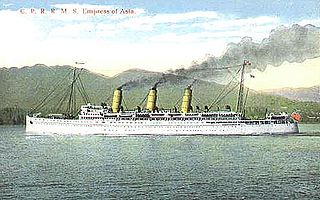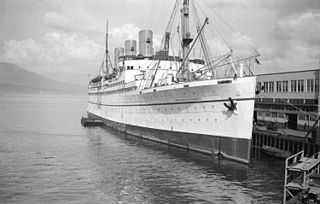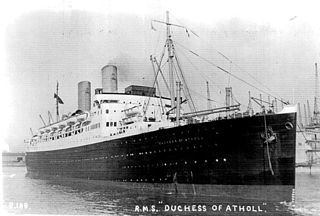
USS Susan B. Anthony (AP-72) was a turbo-electric ocean liner, Santa Clara, of the Grace Steamship Company that was built in 1930. Santa Clara was turned over to the War Shipping Administration (WSA) on 28 February 1942 and operated by Grace Lines as agent for WSA as a troop ship making voyages to the South Pacific. The ship was chartered to the Navy on 7 August 1942 for operation as a United States Navy transport ship. The ship was sunk 7 June 1944 off Normandy by a mine while cruising through a swept channel with all 2,689 people aboard being saved.

Aquitania was an ocean liner of the Cunard Line in service from 1914 to 1950. She was designed by Leonard Peskett and built by John Brown & Company in Clydebank, Scotland. She was launched on 21 April 1913 and sailed on her maiden voyage from Liverpool to New York on 30 May 1914. She was given the title of Royal Mail Ship (RMS) like many other Cunard ocean liners since she carried the royal mail on many of her voyages. Aquitania was the third in Cunard Line's grand trio of express liners, preceded by RMS Mauretania and RMS Lusitania, and was the last surviving four-funnelled ocean liner. Shortly after Aquitania entered service, World War I broke out, during which she was first converted into an auxiliary cruiser before being used as a troop transport and a hospital ship, notably as part of the Dardanelles Campaign.

CP Ships was a large Canadian shipping company established in the 19th century. From the late 1880s until after World War II, the company was Canada's largest operator of Atlantic and Pacific steamships. Many immigrants travelled on CP ships from Europe to Canada. In 1914 the sinking of the Canadian Pacific steamship RMS Empress of Ireland just before World War I became largest maritime disaster in Canadian history. The company provided Canadian Merchant Navy vessels in World Wars I and II. Twelve vessels were lost due to enemy action in World War II, including the RMS Empress of Britain, which was the largest ship ever sunk by a German U-boat.

Manhattan was a 24,189 GRT luxury ocean liner built for the United States Lines, named after the Manhattan borough of New York City. On 15 June 1941 she was commissioned as USS Wakefield (AP-21) and became the largest ship ever operated by the US Coast Guard. In 1942 she caught fire and was rebuilt as a troop ship. Post-war, she was moored in New York in May, before decommissioning in June 1946. She was laid up in reserve at Jones Point, New York. She never saw commercial service again, and was sold for scrap in 1965.

MS Batory was a Polish ocean liner which was the flagship of Gdynia-America Line, named after Stefan Batory, the sixteenth-century King of Poland. She was the sister ship of MS Piłsudski. After Allied wartime service, mainly under the UK Admiralty, she became in 1951 the flagship of the Polish Ocean Lines and the Polish merchant fleet. She is often described as the "Pride of the Polish Merchant Marine". Batory along with her sister Piłsudski were the two most popular ocean liners of Poland.

RMS Empress of Australia was an ocean liner built in 1913–1919 by Vulcan AG shipyard in Stettin, Germany for the Hamburg America Line. She was refitted for Canadian Pacific Steamships; and the ship – the third of three CP vessels to be named Empress of China – was renamed yet again in 1922 as Empress of Australia.

RMS Empress of Asia was an ocean liner built in 1912–1913 by Fairfield Shipbuilding and Engineering at Govan on the Clyde in Scotland for Canadian Pacific Steamships.

SS Duchess of York was one of a class of four steam turbine ocean liners built in Glasgow in 1927–29 for Canadian Pacific Steamships Ltd's transatlantic service between Britain and Canada.

RMS Empress of Canada was an ocean liner launched in 1960 and completed the following year by Vickers-Armstrongs of Walker, Newcastle upon Tyne, England for Canadian Pacific Steamships Ltd. This ship, the third CP vessel to be named Empress of Canada, regularly traversed the transatlantic route between Liverpool and Canada for the next decade. Although Canadian Pacific Railways was incorporated in Canada, the Atlantic liners were owned and operated by the British registered subsidiary Canadian Pacific Steamships Ltd. and were always British flagged and manned and therefore Empress of Canada was not the flagship of the Canadian Merchant Marine.

Duchess of Richmond was an ocean liner built in 1928 for Canadian Pacific Steamships by John Brown & Company in Clydebank, Scotland. In 1947 she was renamed Empress of Canada.

RMS Empress of Canada was an ocean liner built in 1920 for the Canadian Pacific Steamships (CP) by Fairfield Shipbuilding & Engineering Company at Govan on the Clyde in Scotland. This ship—the first of three CP vessels to be named Empress of Canada—regularly traversed the trans-Pacific route between the west coast of Canada and the Asian waters until 1939.

Asama Maru was a Japanese ocean liner owned by Nippon Yusen Kaisha (NYK). The ship was built in 1927–1929 by Mitsubishi Shipbuilding & Engineering Co. at Nagasaki, Japan. The vessel was named after an important Shinto shrine.

SS De Grasse was a transatlantic liner built in 1921 by Cammell Laird, Birkenhead, United Kingdom for Compagnie Générale Transatlantique, and launched in February 1924. In August 1924 De Grasse set sail on her maiden voyage from Le Havre to New York. After the fall of France to Nazi Germany, the ship was used as a barracks ship. Sunk at Bordeaux, France, during the German retreat, she was refloated, repaired, and put back into service. Over the years, she became Empress of Australia and then Venezuela. She ran aground off Cannes, France, in 1962 and was scrapped at La Spezia, Italy.
Two ships of Canadian Pacific Steamships (CP) have been named Empress of France:

The RMS Ascania was an ocean liner operated by the Cunard Line. She was launched on 20 December 1923 at the Armstrong Whitworth Shipbuilders Ltd yard in Newcastle-upon-Tyne; the fifth of Cunard's six "A" class liners. Due to unforeseen cost overruns, the vessel was not completed until May 1925. Following service in a number of military roles during the Second World War, she was refitted and returned to civilian use in 1950, finally retiring in 1956.

HMCS Mayflower was a Flower-class corvette that served mainly in the Royal Canadian Navy during the Second World War but began her service with the Royal Navy. She saw action primarily in the Battle of the Atlantic as an ocean escort. She was named after the flowering plant Maianthemum canadense.

QSMV Dominion Monarch was a UK passenger and refrigerated cargo liner. Her name was a reference to the Dominion of New Zealand. The unusual prefix "QSMV" stood for quadruple-screw motor vessel.

RMS Duchess of Atholl was one of a class of four steam turbine ocean liners built in Glasgow in 1927–29 for Canadian Pacific Steamships Ltd's transatlantic service between Britain and Canada.
RMS Andes was a 26,689 GRT steam turbine Royal Mail Ship, ocean liner, cruise ship, and the flagship of the Royal Mail Lines fleet. She was the second Royal Mail ship to be named after the South American Andes mountain range. The first RMS Andes was an A-class liner launched in 1913. In 1929 that RMS Andes was converted into a cruise ship and renamed Atlantis.

SS Stratheden was a UK-built steam turbine ocean liner. She spent most of her career with the Peninsular and Oriental Steam Navigation Company, including the Second World War when she served for six years as a troop ship.



















